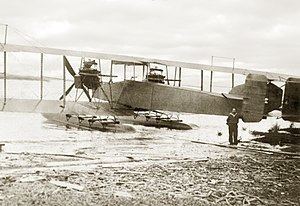Top speed 120 km/h Length 8.6 m Retired 1920 | Wingspan 18 m Introduced 1916 | |
 | ||
Designer Dmitry Pavlovich Grigorovich | ||
Grigorovich M-16 (alternative designation ShCh M-16, sometimes also Shchetinin M-16) was a successful Russian World War I-era biplane flying boat of the Farman type, developed from the M-9 by Grigorovich. The M-16 was a version especially intended for winter operations, with better aerodynamic qualities. It was somewhat larger than the M-9.
Contents
Wartime use
Six M-16s fell into Finnish hands during the Russian Civil War. The first Finnish parachute jump was done on June 17, 1922 from a M-16 by a parachuter named E. Erho. The aircraft were flown until 1923.
Variants
Operators
Specifications (M-16)
Data from Thulinista Hornettiin
General characteristics
Performance
Armament
1x MG
References
Grigorovich M-16 Wikipedia(Text) CC BY-SA
